Travel Tips for navigating San Miguel de Allende’s elevation begin with understanding its 4,593-foot altitude. You might experience initial challenges like shortness of breath and mild altitude sickness when first arriving. Your body will need time to acclimate, so plan for slower movement and extra hydration. The high-elevation environment offers unique benefits, including cooler temperatures and stunning panoramic views, but it also demands careful preparation. You should drink plenty of water, avoid alcohol initially, and listen to your body’s signals. If you have pre-existing health conditions, consulting your physician before traveling is recommended to ensure a safe and enjoyable experience in this beautiful Mexican highland destination.
 Here’s the content for your blog post section:
Here’s the content for your blog post section:
What Altitude is San Miguel de Allende?
The charming colonial city of San Miguel de Allende sits at a high elevation in central Mexico’s highlands. Located in the state of Guanajuato, you’ll find yourself experiencing a unique geographical setting that significantly impacts your travel experience. Its elevated position provides you with stunning panoramic views and a distinctive climate that sets it apart from other Mexican destinations.
Exact Altitude of San Miguel de Allende
Before planning your trip, you’ll want to know that San Miguel de Allende sits at approximately 6,132 feet (1,870 meters) above sea level. This substantial elevation means you should prepare for potential altitude-related effects on your body, such as mild breathlessness or slight fatigue during initial days of your visit.
Historical Context of Its Altitude
At the time of its founding in 1542, San Miguel’s high-altitude location was strategically chosen for defensive purposes and proximity to silver mining regions. The elevation provided natural protection and economic opportunities for early Spanish settlers.
Plus, San Miguel’s altitude played a significant role in its historical development. The city’s elevated position influenced its architectural design, agricultural practices, and cultural evolution. Indigenous populations and Spanish colonizers adapted to the challenging terrain, creating a unique urban landscape that you can still explore today. The high elevation also contributed to preserving the city’s colonial charm, as its remote location helped protect it from significant modernization during different historical periods.
Effects of High Altitude
Assuming you’re traveling to San Miguel de Allende, which sits at an elevation of 6,200 feet, you’ll experience notable atmospheric changes that can impact your body. The thin air and reduced oxygen levels will challenge your physiological adaptation, potentially causing mild to moderate altitude-related responses. Your physical performance and comfort might be temporarily affected as your body adjusts to the elevated environment.
Understanding Altitude Sickness
On your journey to San Miguel de Allende, altitude sickness emerges as a potential travel concern. This condition occurs when you ascend rapidly to higher elevations, challenging your body’s ability to acclimatize. Your respiratory and cardiovascular systems must work harder to compensate for the decreased oxygen pressure, which can trigger various physiological responses.
Symptoms and Who Is Affected
Around 20% of travelers experience altitude-related symptoms when visiting elevated destinations like San Miguel. Individuals of any age and fitness level can be susceptible, with no guaranteed immunity based on physical condition. Your personal vulnerability depends on factors like genetic predisposition, rate of ascent, and individual physiological response.
A comprehensive understanding of altitude sickness reveals that symptoms can range from mild discomfort to potentially serious health risks. Your age, pre-existing health conditions, and overall fitness play significant roles in how you’ll adapt. Younger travelers might experience more intense symptoms, while older individuals could have more nuanced physiological reactions. Immediate medical attention becomes critical if symptoms escalate, particularly if you experience severe headaches, persistent dizziness, or breathing difficulties.
 Here’s the content for the sections you requested:
Here’s the content for the sections you requested:
Coping with High Altitude
There’s no denying that San Miguel de Allende’s elevation of 6,200 feet can impact your travel experience. You’ll need to be prepared for potential altitude-related challenges. The thin air can affect your body differently than lower elevations, potentially causing fatigue, shortness of breath, and mild discomfort. Understanding how to manage these effects will help you enjoy your visit to this beautiful colonial city.
Altitude Sickness Prevention Tips
Around altitude sickness can seriously impact your travel plans, so taking proactive steps is important. You should:
- Stay hydrated with plenty of water
- Avoid alcohol and caffeine initially
- Eat light, nutritious meals
- Take it slow during first days of arrival
Recognizing early symptoms can help you prevent more serious complications.
Gradual Acclimatization Strategies
With San Miguel de Allende’s high elevation, you’ll want to approach your arrival strategically. Plan for a relaxed first day, limiting physical exertion and giving your body time to adjust to the new altitude conditions.
In fact, proper acclimatization is more than just a recommendation—it’s a critical strategy for enjoying your visit. You should plan your itinerary to include rest periods, avoid strenuous activities in the first 24-48 hours, and listen to your body’s signals. Gentle walking, staying well-hydrated, and consuming light meals can significantly help your body adapt to the higher elevation.

Packing for Altitude Comfort
Now that you’re preparing for your trip to San Miguel de Allende, understanding how to pack for its high elevation of 6,200 feet becomes imperative. Your clothing and gear selections can significantly impact your comfort and adaptation to the altitude. Strategic packing will help you manage potential challenges and enjoy your experience in this beautiful Mexican destination.
Essential Clothing and Gear
About your clothing choices, focus on layering techniques to manage temperature variations at high altitude. Pack lightweight, breathable fabrics that you can easily add or remove. Consider bringing a lightweight jacket, thermal underwear, and moisture-wicking shirts. Comfortable walking shoes with good traction are vital for navigating San Miguel’s cobblestone streets and uneven terrain.
Medications and Supplements
At high altitudes, your body requires specific preparation. Consult your healthcare provider about altitude sickness prevention. Consider carrying acetazolamide (Diamox) to help your body acclimatize more quickly. Ibuprofen can assist with potential headaches, and staying hydrated is paramount.
The impact of altitude on your health can vary. Altitude sickness can affect anyone, regardless of fitness level. Symptoms might include headaches, fatigue, dizziness, and shortness of breath. Some travelers might experience more severe reactions, so monitoring your body’s response is critical. Gradual acclimatization, staying hydrated, and avoiding alcohol during initial days can significantly reduce risks.
Here’s the content for the chapter on Hydration and Health Tips:
Hydration and Health Tips
Your journey to San Miguel de Allende requires careful attention to altitude-related health considerations. At 6,200 feet above sea level, the city demands specific health precautions. Consider these crucial tips:
- Drink plenty of water
- Monitor your hydration levels
- Pace your physical activities
- Watch for signs of altitude sickness
Assume that your body will need time to adjust to the elevated environment.
Importance of Staying Hydrated
Any elevation above 5,000 feet can impact your body’s hydration needs. San Miguel de Allende’s altitude increases your risk of dehydration and altitude-related symptoms. Your respiratory and cardiovascular systems work harder, causing faster fluid loss. Drinking water helps prevent potential health complications and ensures a more comfortable travel experience.
Foods and Drinks to Consider
Below are recommended consumables that support your body’s adaptation to high altitude:
- Herbal teas
- Electrolyte-rich beverages
- Hydrating fruits
- Soups and broths
Further exploration of nutrition reveals specific items beneficial for altitude adjustment. Coca tea, popular in high-altitude regions, can help mitigate altitude-related discomfort. Bananas, rich in potassium, support electrolyte balance. Avoid excessive alcohol and caffeine, as these can contribute to dehydration. Consuming light, easily digestible meals will help your body acclimatize more effectively.
Exploring San Miguel de Allende at High Altitude
Once again, you’ll find San Miguel de Allende perched at an impressive 6,200 feet above sea level, presenting unique challenges and experiences for travelers. Your body will need time to adjust to the elevation, which can impact your energy levels and overall comfort. The thin mountain air means oxygen is less dense, potentially causing altitude-related symptoms like mild headaches or fatigue. Staying hydrated, moving slowly, and allowing yourself time to acclimate will help you fully enjoy this beautiful highland destination.
Outdoor Activities and Safety
On your high-altitude adventure, you’ll want to approach physical activities with caution. Walking and hiking can feel more challenging due to reduced oxygen levels. You should pace yourself, take frequent breaks, and listen to your body’s signals. Light exercise and gradual movement help your system adapt. Wearing comfortable clothing, staying hydrated, and avoiding overexertion are key strategies to ensure you enjoy San Miguel’s stunning outdoor environments safely.
Local Attractions and Their Accessibility
Along San Miguel’s historic streets, you’ll discover that most attractions are navigable, though the city’s steep cobblestone streets can be demanding. Your exploration might require careful walking and potentially using supportive walking aids. Many churches, museums, and galleries are accessible, but you should be prepared for occasional uneven terrain and elevation changes that could challenge your mobility.
Another important consideration for your visit involves understanding how the high altitude impacts different attractions. The El Jardín principal and major historical sites are generally accessible, but you might find yourself needing more frequent rest stops. Some museums like the Museo Nacional de la Muerte and the Instituto Allende offer relatively flat access, making them excellent options for visitors still adjusting to the elevation. Consider planning your daily itinerary with strategic breaks and maintaining a relaxed pace to fully appreciate San Miguel’s cultural richness.
To wrap up
Summing up, you’ll find San Miguel de Allende’s elevation of 6,200 feet demands thoughtful preparation. Your health and comfort depend on understanding altitude’s impact, so hydrate extensively, pace your activities, and allow time for acclimatization. You should pack appropriate clothing for temperature variations and consider altitude sickness prevention strategies. By staying informed and attentive to your body’s signals, you’ll maximize your enjoyment of this stunning colonial city. Your proactive approach will transform potential challenges into an enriching travel experience, ensuring you fully appreciate San Miguel de Allende’s unique charm and cultural splendor.
FAQ
Q: How high is San Miguel de Allende, and what impact does its altitude have on travelers?
A: San Miguel de Allende sits at approximately 6,200 feet (1,890 meters) above sea level. This elevated location can cause altitude-related challenges such as shortness of breath, mild headaches, and reduced physical endurance for visitors not accustomed to high-altitude environments. Travelers should plan for gradual activity levels and stay well-hydrated during their initial days in the city.
Q: What health precautions should visitors take when exploring San Miguel de Allende at high altitude?
A: Visitors should drink plenty of water, approximately 2-3 liters daily, to prevent altitude-related dehydration. Light, gradual physical activities help body acclimatization. Travelers might consider consuming coca tea or taking mild altitude sickness prevention supplements. Individuals with pre-existing respiratory or heart conditions should consult their healthcare provider before traveling to San Miguel de Allende.
Q: What are the best strategies for enjoying San Miguel de Allende while adapting to its high-altitude environment?
A: Successful high-altitude travel in San Miguel involves strategic planning. Visitors should schedule rest periods, avoid excessive alcohol consumption, and eat light, nutritious meals. Walking slowly, taking frequent breaks, and listening to one’s body are important. Lightweight, breathable clothing and comfortable walking shoes will enhance mobility and comfort while exploring this beautiful colonial city.





I really appreciate your insights about managing the effects of elevation in San Miguel de Allende. Having traveled to other high-altitude cities like Cusco and La Paz, I can definitely relate to the challenges of acclimatization. It’s fascinating how our bodies react in these different environments; sometimes it feels like a race against time to adjust before we start exploring!
It’s great to hear that you found my thoughts helpful! Traveling to high-altitude places like Cusco and La Paz certainly adds an interesting layer to the adventure. Each city brings its own unique charm, but the challenge of acclimatization can really shape how you experience them.
I’m glad you found my insights helpful! If you’re looking for more tips on acclimatizing and making the most of your high-altitude adventures, check out this resource for some great strategies.
https://fallinginlovewithsanmiguel.com/book-attractions
Navigating the elevation of San Miguel de Allende certainly poses unique challenges, but it also enhances the overall experience of visiting this captivating city. Having visited myself, I can attest to the importance of taking the acclimatization process seriously. During my first few days, I underestimated how the elevation could affect my energy levels and breathing, which served as a crucial reminder of the body’s need for adjustment.
Your post captured the essential preparations needed for visiting San Miguel de Allende, particularly regarding its elevation. When traveling to high-altitude destinations, I’ve found that acclimatization is often overlooked, leading to misadventures for many travelers. For instance, on my first trip to a similar elevation in Cusco, Peru, I underestimated the effects of altitude and ended up feeling quite unwell. My experience taught me the importance of not only staying hydrated but also taking things at a slower pace—having a leisurely stroll through the charming streets or indulging in local cuisine can help with both acclimatization and full enjoyment of the vibrant culture.
I appreciate your insights on navigating the elevation of San Miguel de Allende. It’s such a fascinating city, rich in culture and history, but it’s easy to underestimate the impact of its altitude on our bodies. I remember my first trip there; I was so excited to explore that I rushed into activities without giving myself time to acclimate. The shortness of breath hit me like a brick wall, and I found myself taking a lot of breaks just to catch my breath, which was frustrating because I wanted to soak in all that stunning architecture and vibrant street life.
San Miguel de Allende does have a way of stealing your breath—both figuratively and literally. Your experience resonates with many, I’m sure. The excitement of a new place can easily sweep us off our feet, but the altitude can catch you off guard if you’re not careful. It’s amazing how an elevation of over 6,000 feet can turn a leisurely stroll into a bit of a challenge.
I completely relate to your insights about navigating the altitude in San Miguel de Allende—it’s such a fascinating place, but that elevation really does sneak up on you, doesn’t it? When I visited a few years back, I recall feeling that initial shortness of breath while just walking a couple of blocks! It took some getting used to, and I definitely underestimated how much sipping on water would help.
Your insights on navigating the challenges presented by San Miguel de Allende’s elevation are incredibly valuable, especially for travelers who may be unfamiliar with the effects of altitude. As someone who experienced the initial discomfort of altitude sickness during my visit to another high-elevation city, I can personally attest to the importance of acclimating properly. I remember arriving in Quito, Ecuador, which sits at a similar altitude, and underestimating how the thinner air would affect my body. I was initially caught off guard by the mild headaches and fatigue, and it wasn’t until I slowed down, stayed hydrated, and allowed myself to adjust that I began to fully appreciate the city’s vibrant culture and stunning views.
Your experience in Quito really highlights how tricky adjusting to high elevation can be. It’s interesting how our bodies respond differently depending on the environment, isn’t it? I remember when I first visited San Miguel de Allende, I had to remind myself that it’s not just about the beauty of the place, but also about taking a moment to pause and let the body catch up.